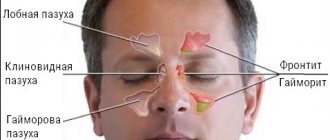What antibiotics to take for frontal sinusitis in adults?
Antibiotics for frontal sinusitis are used in both acute and chronic forms.
- If frontal sinusitis is acute, it is often recommended to increase the initial dose of the drug.
- The duration of antibiotic therapy rarely exceeds a week.
- For chronic frontal sinusitis, antibiotics are taken longer than for acute sinusitis.
- It is possible to change them and adjust dosages, due to the cessation of the therapeutic effect from the previous one
A study to determine the pathogen and sensitivity to certain antibiotics of mucus from the frontal sinuses will be relevant. Prescribing antibiotics for frontal sinusitis of a fungal nature is ineffective and inappropriate.
Self-prescription of antibiotics is not recommended. Only a specialist can correctly prescribe antibacterial therapy, taking into account the nature of the pathogen, the patient’s condition, the course and characteristics of frontal sinusitis.
For frontal sinusitis, the following groups of antibiotics are in demand: macrolides, penicillins, tetracyclines, cephalosporins.
Choice of antibiotic
Modern pharmaceuticals can offer a huge number of antibiotics, but you should not self-medicate, because only a doctor can make the right choice and tell you which antibiotics to take for sinusitis. Most often, an antibiotic is chosen by an empirical method, which is based on knowledge of the main types of pathogens of a given disease and the width of the spectrum of action of various groups of antibiotics. However, a method for determining the sensitivity of a microbe to antibacterial drugs is not excluded.
Acute sinusitis:
The drugs of choice for mild to moderate cases are penicillins. The most effective of this group of drugs is amoxicillin, however, some types of bacteria can develop resistance to it, so do not forget about this form of penicillins, such as protected penicillins (amoxicillin/clavulanic acid). These drugs are used orally for 7 to 10 days. In case of frequent recurrence of acute sinusitis (2-4 times a year), it is preferable to prescribe cephalosporins of the second or third generations (cefuroxime, ceftriaxone, cefaclor). In case of severe disease, parenteral (intravenous, intramuscular) administration of antibiotics is necessary.
Second-line drugs can be cephalosporins (cefaclor, cefuroxime), macrolides (clarithromycin, azithromycin), doxycycline, chloramphenicol. They are also used for about 7-10 days, except for azithromycin, its course is 3 days. In case of frequent relapses, fluoroquinolones are effective drugs, but these antibiotics are used for sinusitis in adults. Their use in children is not permissible. These include ofloxacin, ciprofloxacin, hepafloxacin, etc.
Chronic sinusitis:
In case of exacerbation of chronic sinusitis, the same antibacterial agents are used as for acute sinusitis. The duration of the course of antibiotics can be up to 3 weeks.
Hospital-acquired (nosocomial) sinusitis:
- Requires mandatory puncture of the sinuses with subsequent determination of the pathogen and its sensitivity to antibiotics.
- For treatment it is necessary to use a combination of several antibiotics:
- III-IV generation cephalosporins (cefotaxime, ceftriaxone, cefepime, cefpirome) in combination with aminoglycosides (gentamicin, amikacin)
- protected penicillins (amoxicillin/clavulanic acid) in combination with aminoglycosides, fluoroquinolones or carbopenems (meropenem, imipenem).
For sinusitis in children, antibiotics are not contraindicated, but it must be remembered that not all groups of drugs can be used. Thus, fluoroquinolones are not used in children. The use of tetracycline drugs (doxycycline) is only possible in children over 8 years of age. It is preferable to use local forms of antibiotics, such as Bioparox, which is used as a nasal spray. However, it must be remembered that it can cause laryngospasm; it can be used in children starting from 2.5 years old. Penicillins are the drugs of choice for children of any age.
Share the article on social media. networks:
Macrolides
Macrolides are the drugs of choice for the treatment of frontal sinusitis in any form.
- Azithromycin . This is the main representative of this group, used for frontal sinusitis. It has a wide spectrum of action, side effects are relatively rare. It is contraindicated in case of individual intolerance or kidney failure.
- Erythromycin . It has a wide spectrum of antimicrobial activity. Due to its similarity to penicillin antibiotics, it is relevant when patients are allergic to penicillin. Contraindicated in case of kidney or liver failure.
Penicillins
A less wide range of bacteria is sensitive to this group. The following antibiotics are used to treat frontal sinusitis.
- Amoxicillin . This drug effectively fights infections caused by staphylococci, streptococci, pneumococci and gram-negative bacilli. It is usually used in a short course, since bacteria quickly adapt to it.
- Augmentin . This antibiotic has a wide spectrum of activity. It is represented by a compound of amoxicillin and clavulonic acid, thanks to which it becomes more effective. Side effects include nausea, skin rashes, and allergic reactions.
Symptoms and treatment of frontal sinusitis: what medications to take for frontal sinusitis?
Frontitis is an inflammation of the frontal sinuses. It gives a person a lot of painful sensations. Perhaps this is the most unpleasant of all sinusitis. It can be recognized by the following signs:
- high temperature;
- pain above the bridge of the nose;
- copious discharge from the nose, often greenish in color;
- difficulty in nasal breathing.
Temperatures can rise to 39–40 degrees and above. Characterized by poor general health - weakness, headaches, fatigue. Local symptoms vary in severity - from mild discomfort in the bridge of the nose to sharp, piercing pain, sometimes throbbing. They are more pronounced in the morning.
The area of the forehead above the bridge of the nose is painful when pressed. In severe cases of the disease, the skin above the bridge of the nose becomes swollen or even red, pain in the eyes and photophobia appear.
If a person has symptoms similar to frontal sinusitis and treatment is started on their own, if possible, they should coordinate it with an ENT doctor as soon as possible. Improper treatment can contribute to the transition of frontal sinusitis to a chronic form or provoke complications.
Medicines for sinusitis eliminate infection in the sinuses and fight inflammation. They reduce swelling and improve ventilation of the sinuses and the drainage of purulent contents. In most cases, acute frontal sinusitis responds well to medication. Treatment of exacerbations of chronic frontal sinusitis is carried out using the same methods.
Symptoms of acute sinusitis
The disease is accompanied by an increase in body temperature to 39 °C and sharp pain in the forehead area. Unpleasant sensations intensify when bending forward or applying pressure, including on the area of the eye sockets. There may be swelling of the tissue in the corner of the eyes. The main symptoms of frontal sinusitis also include headaches, severe difficulty in nasal breathing, excessive lacrimation, and photophobia.
Discharge from the nose does not have an unpleasant odor; at the initial stages of the disease it is serous (watery, colorless), then becomes purulent (thick, yellowish or greenish). Cleansing the frontal sinuses is accompanied by relief and reduction of pain. During a medical examination, redness and swelling of the mucous membrane of the nasal turbinates is also observed.
Symptoms of chronic sinusitis
Manifestations of the disease are less pronounced, but they bother you for a long time. Chronic frontal sinusitis is accompanied by pressing and aching pain in the forehead. Unpleasant sensations intensify with the accumulation of pus in the sinuses. Acute pain occurs when pressure is applied to the eyebrow or inner corner of the eye. Nasal discharge is purulent and has an unpleasant odor.
- pain and tightness in the frontal sinuses;
- inflammation of the nasal septum;
- severe ear pain;
- a severe cough appears;
- increased body temperature;
- swelling of the eyelids.
The manifestation of symptoms of the disease in adults and children mainly occurs during sleep and when bending down. But with sinusitis this does not happen, which is why it is very important to distinguish these two diseases from each other.
In severe and advanced cases, the patient's sense of smell and taste sharply decreases, and a sore throat occurs. If the disease is not treated, it can cause a complication - meningitis, that is, inflammation of the lining of the brain.
Cephalosporins
Antibiotics of this group have a wide spectrum of action. They are effective in the treatment of frontal sinusitis.
The most popular 3rd generation cephalosporin is Ceftriaxone. It is relatively well tolerated by patients. Contraindicated for pregnant and breastfeeding women. Available for injection. It is administered intravenously and intramuscularly.
In some cases, the doctor prescribes analogues in suspension. Suprax is a 3rd generation broad-spectrum antibiotic taken orally. Great for pregnant women and children.
Local preparations
Local preparations that contain antibacterial enzymes are also used. Among them are Bioparox, Isofra.
Bioparox for frontal sinusitis . It is an aerosol with antibacterial and anti-inflammatory effects. It is also active against some fungi. It is used in the form of inhalation into the nose. And also in the throat. It is found in low concentrations in the general bloodstream.
Sinupret for frontal sinusitis . It is a herbal preparation with antimicrobial, anti-inflammatory and secretolytic effects. It is used internally in the form of drops and tablets.
Local form of antibiotics
This type of drug can be used in several ways, namely:
- nasal drops and spray;
- nasal swabs, which are impregnated with a special medicine;
- aerosol.
When using Bioparox aerosol with the addition of an antibiotic, it is able to eliminate the inflammatory process.
The drug Isofra (sprays and nasal drops) is made from drugs that do not have a toxic effect on other organs.
A spray called Polydexa contains 2 types of antibiotics that can cover the foci of the infectious agent. One component significantly reduces nasal secretions, while the other has anti-inflammatory properties.
Tampons impregnated with medicine have antibacterial properties, with the help of which pus is released under the influence of a special composition of the drug.
Frontal sinusitis must be treated in a timely manner under the strict supervision of a doctor. Since the disease can cause serious complications, treatment of the disease with antibiotics is considered the most effective.
Depending on the duration, there are three main forms of frontal sinusitis:
- acute – symptoms persist for less than 4 weeks, no further relapses are observed;
- subacute – the duration of the disease varies from 4 weeks to 3 months;
- chronic - symptoms bother the patient for more than 3 months; exacerbations of frontal sinusitis usually occur against the background of colds (ARVI).
In turn, acute frontal sinusitis is also divided into two types:
- catarrhal - accompanied by nasal congestion and moderate discharge, discomfort in the superciliary area; with adequate treatment, complete recovery occurs; in its absence, a transition to a chronic form is possible;
- purulent - accompanied by the addition of a bacterial infection and the accumulation of pus in the frontal sinuses; this form of frontal sinusitis is more severe and requires treatment with antibiotics.










